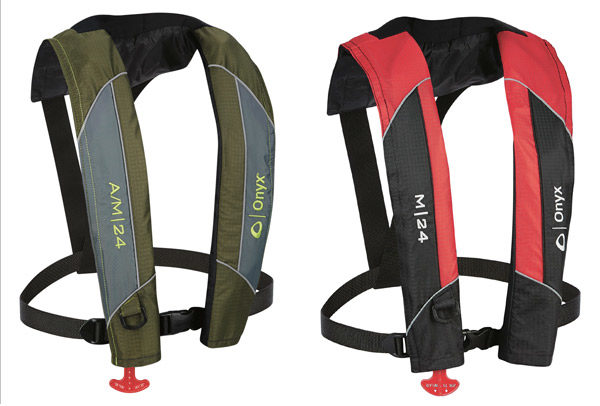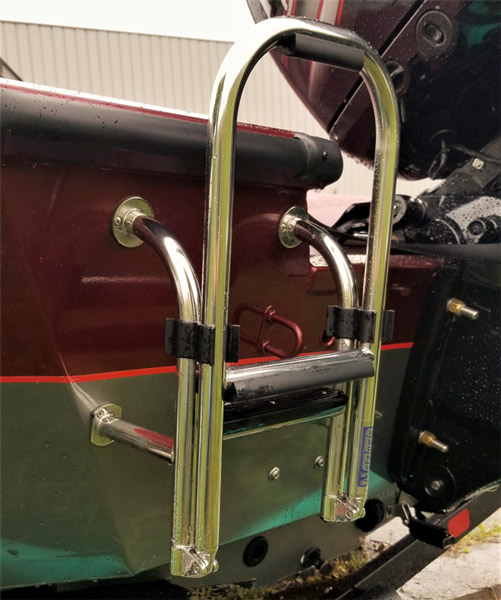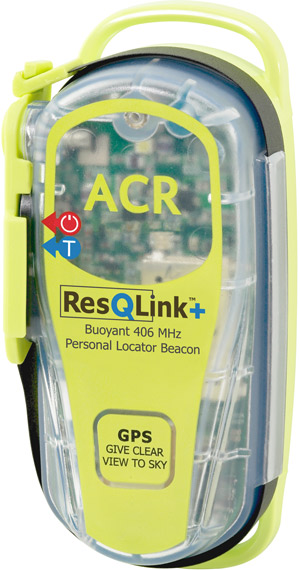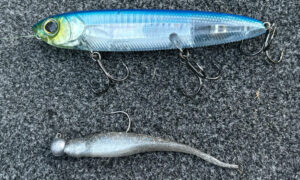by Keith Jackson
[Note: We are not endorsing any particular products. Any linked or showed products are just examples. Please do your own research.]
Last January’s tragic accident, where Nik Kayler lost his life in an FLW tournament, caused a lot of talk about tournament safety. Bass-heads had a lot of concern about PFDs and even PLBs (Personal Locator Beacons), cold weather/water, big water, and the need for bass fishermen to recognize that fishing in cold weather isn’t the same as in flip-flop weather.
Important stuff, but other than emails and chatrooms, we didn’t see much written about these topics. So here’s the scoop on several of the topics raised by concerned bassers.
1. Inflatable PFDs
Do inflatable PFDs work reliably? Do they only work in certain conditions? Those are the main questions that were asked. After doing the research, Here’s the deal: You should NOT be wearing an inflatable PFD when it’s cold…or when the water’s cold.
Don’t believe it? Read your owner’s manual.
It will probably say that when temps are below 40 degrees, the PFD inflates “very slowly” (with the CO2 cartridge). AND if that PFD is stored outside in your boat when air temps are below freezing, it may not work at all until the cylinder warms.
It’s worth noting that inflatable PFDs “are not to be worn when the [air] temperature is below freezing,” according to inflatable PFD maker Onyx Outdoors, unless the PFD “is partially inflated” manually. BUT that could cause another issues — check this out from a Mustang PFD owner’s manual:
> When the temperature is below freezing, a fully discharged cylinder may not adequately inflate your PFD. Do not use your PFD under these conditions unless it is already partly inflated. Warning: CO2 inflation could over-pressurize and damage your PFD if already fully orally inflated.
Above freezing, in cold temps, the PFD will inflate but will do so slowly — the colder, the slower. And it’s likely that a partially inflated PFD won’t support a fisherman in the water.
In case you’re tempted to warm your PFD inside your jacket, the manufacturers say that an inflatable PFD should only be worn only on the outside of clothing or rainwear.
We all know reports of PFDs failing to inflate when wearers were dumped in the water. Onyx says it rigorously investigated each situation involving its own PFDs [Note: Mustang did not respond to repeated requests for interviews]: “We have not seen any issues of a properly armed and maintained automatic [inflatable] not inflating when needed,” said Wayne Walters, director of compliance for Onyx.
In some of the cases Onyx investigated, fishermen were wearing manual PFDs — which means that the wearer has to manually trigger the inflation: If the cord isn’t pulled, the PFD won’t inflate. That might seem obvious, but fishermen who are used to wearing automatic inflatable PFDs may not realize that manual versions exist.
[Here’s an Onyx Automatic/Manual vest on the left, and a Manual-only vest.]

This means that when you put an inflatable on, it’s imperative that you check what kind it is as well as the status indicator of the PFD. To check whether or not the PFD is functional, you need to look at the bobbin — a moisture-sensing device found in the inflation mechanism. The bobbin has a date stamp on it and should be replaced every 3 years. Standard rearming procedures should be followed.
How to maintain an inflatable PFD:
> Routinely check the status indicator as well as the condition of the bladders, cover and webbing. It’s key to make sure there are no punctures, tears or worn spots in the bladder or cover.
> Besides the visual inspection of the bladder and service indicator on the inflator, the PFD should be orally inflated every 2 months — especially so if it’s stored in a place where it can be inadvertently punctured by something like a hook. It should hold air for 2 hours or so after oral inflation.
> Function and rearming of the automatic/manual PFD — more Onyx vids here:
A few more things:
> After the PFD has been inflated once, the CO2 cylinder must be replaced.
> As is the case with all PFDs, inflatables need to fit the size of the person wearing it — check the sizes in your boat.
> Don’t just take it out of the package and throw it in the boat: The webbing should be adjusted for a snug fit.
> Onyx says people under the age of 16 should not wear an inflatable.
When an inflatable is properly maintained (check the owner’s manual) and its “working conditions” are met, it should work fine — but again, cold weather/water makes it function slower or not at all.
Concerns about inflatables
Last year the Alabama Student Angler Bass Fishing Association banned the use of inflatable PFDs in its tournaments. “The benefits just don’t outweigh the risks,” says association president Barry Corbman. “We [the board of directors] have been discussing this for several years, and this year we decided to end” the use of inflatables.
“One of the reasons was the FLW accident at Okeechobee, and the other was something that happened in one of our tournaments,” he said. In the latter case, 2 anglers and a boat captain were ejected from a boat when it hit a wave wrong. He said each was wearing an inflatable PFD and “only 1 of those inflated.”
“Fortunately the kill switch worked, and the people were able to get back in the boat. That probably was the only thing that saved them because they were well away from everyone. And it could have been really bad because [one of the anglers] was unconscious in the water.”
The decision to ban inflatable PFDs was made shortly before a tournament, and because of the short notice a 1-tournament use was allowed after all PFDs were inspected. “We found several where the bobbin that pierces the CO2 cartridge was past its use-by date, several where the vests had been deployed and one where the cartridge was empty.”
For them, inflatable PFDs were “just a gamble that we are’’t willing to take,” he said.
The ASABFA has over 2,000 members representing over 100 schools, some of which are middle schools — and inflatable PFDs are sized for adults and not for use by those under the age of 16, according to the U.S. Coast Guard.
Both B.A.S.S. and FLW were aware of the decision of the ASABFA, but neither organization is enacting the same ban…yet.
Last year B.A.S.S.’s Dave Precht said: “We’ve not made any changes. We are well aware of concerns, and our Elite advisory board will be discussing it…. Currently we require all tournament anglers to wear USCG-approved PFDs, and that means that anglers under 16 years cannot use inflatable PFDs.”
FLW PR director Joe Opager said last year that the ASABFA’s decision “will not influence any rule decision we make as an organization. We are constantly assessing our rules and policies across all of our tournament circuits to keep safety at the top of mind for anglers. At this time, Coast Guard-approved inflatable PFDs are allowed for anglers 16 years of age and older, per state law.”
> For more information on PFDs and their appropriate uses, check out the Coast Guard’s classification of PFDs.
2. Cold weather and hypothermia
First, just know that whatever the water temp is, it’s WAY colder and worse for you than you think it is, unless we’re talking dead summer. So if someone falls in, hypothermia can happen even if air temps are mild.
Fall into 50-degree water (and stay there), and you’ll lose motor function (hands, arms, feet, legs) in 15 minutes or less. You’ll lose consciousness in an hour or so, and probably your life in 4 hours.
Get back in the boat, and if air temps and wind are against you, then windchill sets in. If the air temp is 40 degrees and there’s a Wiggle Wart friendly 15 mph wind, the windchill is 32 degrees. With wet clothes, hypothermia will come on incredibly fast.
How do you protect yourself from hypothermia? Obviously the first step is to stay in the boat and stay dry. Also, warm, dry clothes should be tucked away somewhere in the boat just in case: In cold weather it’s imperative to stay dry — getting back into dry clothes immediately is mandatory.
An often-overlooked option that combines the whole stay dry/warm thing with the need for a PFD is a flotation coat. Onyx and Mustang both make coats that meet USCG standards as Type III PFDs. They’re waterproof, and given that they use foam for flotation, they help keep body temps up in the event the wearer goes overboard.
Yes, they can be fished in. I have had an older Stearns coat that I used for years salmon fishing. The newer models are better.
A few more things:
> Make sure your boat has a ladder (e.g., transom ladder). No matter how young or in-shape you are (or think you are), when your body hits cold water and you’re fully clothed, it’s going to be a lot harder to get back into the boat than you think it is. It may even be impossible without a ladder. T-H Marine has several versions — here’s one that mounts to a jack plate:
Here’s one on a Vexus Boat:
> A significant portion of drowning deaths of fishermen fishing alone is when they relieve themselves over the side of the boat. They probably stand too close to the edge then fall/slip in. So make sure you’re wearing a PFD when you’re going #1, and don’t be afraid to get some p** on your boat (it washes off!).
> Try not to have your cell phone in your pocket unless it’s in a waterproof case.
> The “Heat Escape Lessening Position” helps maintain core body temps if you fall in:
> Know your limits. Even if you have a 22′ Ranger, you might be outmatched by the conditions. Don’t think that because [Elite pro name] with the same boat can run 6-footers on Lake Ontario that you can run 4-footers on your home lake. Be humble. Safety first.
3. How ya gonna call?
Despite careful preparation, accidents happen. Equipment breaks. What if you’re fishing in the middle of Lake Okeechobee, in one of the arms of Lake of the Ozarks or Guntersville (both with about 1,000 miles of shoreline), or back in the dunes at WA’s Potholes Reservoir? In those situations, getting help to you can either be nearly impossible or a long time coming…even if you can call someone.
And what if your buddy has a heart attack? Or that cottonmouth that hitched a ride bites you?
If you’ve got your cell phone and have a couple bars on it, you can call for help. But cell phones don’t always work where we fish, especially if you’re traveling to fish:
> Coverage can be sketchy even on some of the best-known bass waters, especially if you’re in the back of a creek with hills on both sides.
> Cell phones can stop working when they get wet, including when you fall in.
> You can forget to charge them, or the battery might be low.
> For whatever reason, your phone just fails to work.
We’ve all been there.
Fortunately, there’s 2 other ways to call the troops when they’re really needed, and both are readily available. They can send a Mayday signal and a location to satellites that then forward the signal to folks who can help. These devices are called EPIRBs (Emergency Position Indicating Radio Beacons) and PLBs (Personal Locator Beacons).
EPIRBs are designed for marine use — like commercial marine use — and are registered to a boat. PLBs are registered to a person, and work on water or land so they can also be used while hunting or camping.
The short version of the differences between the two devices is that EPIRBs are larger, more expensive and not intended for recreational fishermen. PLBs are much smaller (fit in a pocket) and are roughly half the cost — some under $200. Some PLBs also allow for emergency emails, such as “I’m fine” to family in the event of an accident. Here’s an example of a PLB:
Note: Both are intended for use in LIFE-THREATENING situations — NOT for calling for a new prop.
Both types of beacons operate with a satellite system that sends a 406MHz frequency distress signal to a rescue coordination center. The center then contacts the appropriate rescue agency based on the coordinates given by the beacon.
Most beacons send GPS coordinates to the rescue agency. Some of the older ones used less-accurate location information, so stick to new GPS-enhanced beacons that can pin the unit’s location to within 50 meters.
Once activated, PLB units should last for 24 hours. Some will also have a flashing strobe light.
Before buying one, shop for the features you really need. Make sure you understand whether a subscription to a service is required.
One example
One maker of PLBs —ACR Artex — publishes stories on its website where having a PLB saves lives. Nothing about bass fishing on there, but here’s a quick one about duck hunting in FL:
> “It was about 50 degrees out that morning, and the wind was blowing pretty good. We were working our way around the area and away from shore…the waves picked up…so I put the bow [of his 15′ Gheenoe] directly into them. As I tried to gain speed, I looked back and water was pouring into both sides towards the transom…and in less than 5 seconds the boat was capsized.”
He said that once the “adrenaline wore off and we realized how cold it was,” they decided to activate an ACR PLB:
> “Before we knew it, an Osceola County Sheriff’s helicopter was hovering over us.”
The rescue was completed by fishermen in a bass boat [stout!] who brought the hunters to shore, where they were met by sheriff’s deputies and EMTs. They were “mentally okay,” but their body temps were 91 degrees…the point at which a person starts to have difficulty thinking and remaining conscious:
> “We were very fortunate to have the ACR PLB on us, and know that the outcome could have been much worse if we spent much more time out there.”
One more thing: Sea Tow and ACR teamed up in a program that has PLBs available for short-term rental.
4. More safety stuff
This isn’t supposed to be a comprehensive examination of everything about boating safety, but here’s a couple more things to think about:
> Does your boat meet the Coast Guard requirement that a Type IV throwable device is “immediately available?” A USCG-approved cushion meets the standards, but other possibilities include a Throw Raft — an inflatable cushion that works off a CO2 cartridge…with the same consideration about air/water temps.
> Another safety item is a throw bag, basically a bag that contains coiled, floating rope, generally 50′ or more. It’s heavy enough to throw to a man overboard, and the floating rope can help pull him back to the boat.
> This might work: Walleye pro Mike McClelland (not the bass pro of the same name) once told a story about falling out of his boat on Lake Oahe when he was pre-fishing a tourney. He was alone and couldn’t get back into his boat, a deep-vee aluminum. He worked his way to the stern and used the trim on his motor to give him a boost: He straddled the motor, hit the trim button and got back onboard.
5. How it looks to me
Like a Boy Scout, be prepared — because accidents are unpredictable. And who knows, the accident or breakdown may not even happen to you — you just might be there to help. Either way, here’s my 2c:
> Inflatable PFDs should NOT be used (or allowed in tournaments) where air and water temps are below 40 degrees.
> A Personal Location Beacon is something we should think about adding to our boat gear.
> Every boat should have the equipment necessary to reach someone overboard and get him or her back in the boat safely.
> Cold conditions and big water are no joke. Treat both with care. Safety first.































